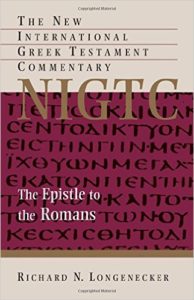 The Epistle to the Romans (NIGTC), by Richard Longenecker (Eerdmans, 2016), 1004 pages.
The Epistle to the Romans (NIGTC), by Richard Longenecker (Eerdmans, 2016), 1004 pages.
Reviewed by David Barry
Richard Longenecker is a senior scholar and professor emeritus of New Testament at Wycliffe College at the University of Toronto. As such, he exhibits a dexterity with a wide breadth of academic sources that springs from a life committed to biblical investigation. This most recent foray into Romans scholarship is not his first, or second, but he would be hard pressed again to produce so comprehensive a contribution than this Greek testament commentary.
The NIGTC series is primarily produced “for students who want something less technical than a full-scale critical commentary,” nevertheless, it will “attempt to treat all important problems of history, exegesis, and interpretation that arise from the New Testament text” (p. ix) That is, the goal is a comprehensive treatment of the important problems. At over 1,000 pages, the commentator seems to have taken that goal to heart.
The treatment of each pericope is divided into six basic categories: (1) Translation, (2) Textual Notes, (3) Form/Structure/Setting, (4) Exegetical Commentary, (5) Biblical Theology, and (6) Contextualization for Today. Depending on length, he sometimes divides each of those sections further. Of course, the lengthiest by far is the exegetical portion.
In his 39 page introduction, Longenecker rejects the once-popular view of Romans as a doctrinal treatise in favor of viewing it as occasional, prompted by historical circumstances. He covers the typical introductory questions of provenance, authorship, date, occasion, genre, as well as introducing major interpretive debates. He also alerts the reader to the distinctive exegetical treatments of the commentary (pp. 18-20).
One such distinctive is his rejection of previous theories of the genre of Romans in favor of the more novel “Hellenistic protreptic speech.” These exhortations would typically have three sections: negative, positive, and (sometimes) hortatory (pp. 14-16). He ascribes 1:16-4:25 to the negative section, 5:1-8:39 to the positive, and 12:1-15:13 to the hortatory, following the generally accepted four part divisions of the main body of the letter (1:16-15:13). Next, he argues that Paul added an unusual third major section, 9:1-11:36, because it “would have been of particular interest to the Christians at Rome who understood and expressed their commitment to Jesus in ways that had been largely transmitted to them by Jewish believers” (p. 145; cf. pp. 14-16). He then interprets each of these four major sections in light of its “protreptic” designation.
A second distinctive of this commentary is Longenecker’s view of 5:1-8:39 (cf. pp. 538-47). He sees Paul’s contextualization of the gospel to the Gentiles as his “spiritual gift” (Rom 1:10) and a primary reason the epistle was written. In his introduction to that section he writes, “Our thesis is that in 5:1-8:39 Paul sets out the basic features of the Christian gospel as he had contextualized that message in his Gentile mission to those who had no Jewish heritage and no biblical instruction” (p. 547).
One noteworthy strength of this commentary is that which is not, strictly, commentary. Longenecker will typically begin a section by pointing out various positions or technical difficulties in the following material. He does this with the seasoned discernment of a senior scholar. There are, however, issues that will give some readers pause. The first regards Longenecker’s interpretation of the use of the OT in Romans. He has a history arguing for NT authors’ non-contextual use of the OT and continues with that position. For instance, Longenecker asserts a Pauline “disregard” for the original context of Deut 30:12-14 when it is cited in Rom 10 “to the advantage of his argument” (p. 23). However, perhaps most significant is the complaint that, for a Greek testament commentary, the amount of printed interaction with the Greek text is, perhaps, less than may have been expected.
Despite these quibbles, Longenecker’s Romans is, without question, a masterful contribution to Pauline studies. His grasp of the subject matter and various interpretive options is deep. In addition to being commentary upon the Greek text itself, Romans can also function as a history of exegetical problems in the investigation and interpretation of Paul’s longest and most intricate work. From now on, anyone studying the Greek text of Romans will want to do so with this commentary close by.
Preview or buy it here.



One comment